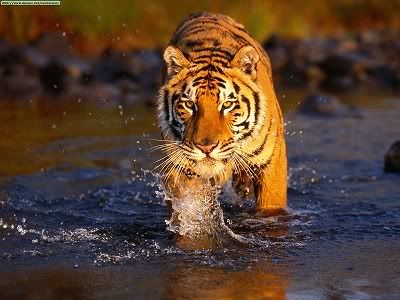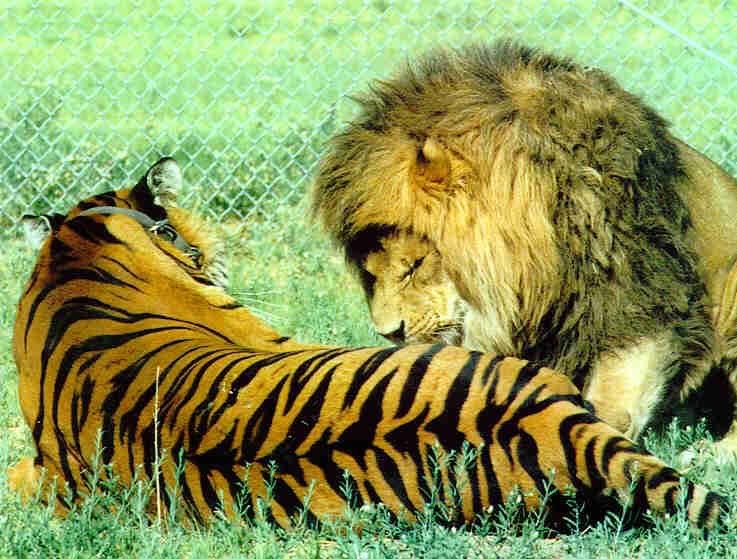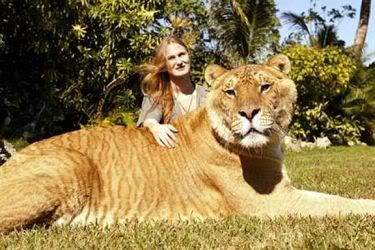The tiger is the largest of the cats and is a perfect killing machine with a superior combination of power, cunning and agility.
On the other hand, A lion has an appearance to frighten even the mightiest of animals. There have been some real fights between the two kings of the jungle.
So, what do the evidences and experts (and common sense) say about who will win a fight between the two, or rather, if there are 100 tiger-lion fights which one will have more victories?
THE LIKELY WINNERCaptive animals:Captive animals often behave differently than the wild ones. In a fight between captive animals, a
tiger will have the advantage of size and power. A captive lion will lack the fighting experience of a wild one.
Let’s now talk about
‘wild’ animals, ie, both the animals are at their prime and have been captured fresh from their natural habitat and are in good natural condition.
In small pit/cage:Lion will have a slender advantage if the fight is in a small closed area since it may get the benefit of taller structure and the mane and the tiger may feel the lack of space.
Agility may not be a big factor. But it may really depend on the size of the respective animal. If the tiger is significantly larger than the lion, the lion may not get a chance to do much harm to the tiger.
In a large area (forest/grassland or even a large ‘cage’):Tiger may win easily. The stronger hindquarters come into play here. It helps to keep balance and make fast movements.
If the two animals are ignorant of each other’s presence at the begining, it will really be a tiger’s game. Siberian tigers are sometimes reported to predate on female/young brown bears. The female bears may be larger than the tigers and as aggressive as the male ones. But the tiger stalks the bears and then and hunts them.
In a similar way, if a tiger and a lion are released in a forest/grassland, a
tiger’s stealth-attacks may be decisive.
Why The Tiger Has a Better Chance of Winning:There is a popular notion that a lion is meant for fighting whereas a tiger is meant for hunting and hence a lion will win in a tiger-lion fight. Some people mention that like a pitbull can own larger dogs, a lion can defeat a tiger since, like the pitbull, the lion is meant to be a fighter.
This is a bad comparison. That a lion plays the role of a fighter in a pride doesn’t make the tiger a non-fighter and just a predator.
A tiger predates AND fights. And that’s why they are way more active than lions.
Over their lifespan, a lion fights other lions less than ten times. This may be well less than the number of tiger-fights a tiger has to face over food/mating/territory. A lion may have to fight off hyenas, too. A tiger, on the other hand, fights with leopards, wolves, dholes and black/brown bears over food/territory.
The ’strength’ analysis is of course an ideal one. A lot of them may prove to be invalid in real fights. Most of the
‘documents’, ‘eye-witness accounts’ and vidoes (though most of them are manipulated to suit the story of movies) show that there is more chance of a tiger winning the fight than a lion winning it. It seems that a tiger might be reluctant to fight at first. But if compelled to, it’s a much
better and more powerful fighter than a lion.Size does matter. An average Bengal/Siberian tiger measures 10 feet and 500 lbs. Can measure up to 11 feet and ~620 lbs. Lions average 9 feet and 410 lbs. Can grow as large as 10 feet and 530 lbs. (Not considering the more extreme cases for either cat). Clearly, tigers have an advantage.
Additionally, the build of a tiger provides much more balance and agility. The weight of a tiger is more evenly distributed over its body-length than that of a lion. A tiger’s tail, being heavier compared to a lion’s, makes it easier for the tiger to turn. And if the
animal with larger size also has greater agility, it’s the one that should win more fights. Add to that the advantages of
bigger paws, faster swipes and longer canines!An African lion, hailing from a place where it doesn’t get much competition from other animals, attacks from the word ‘go’. On the other hand, a tiger, coming from places where it fights bears, wild dogs etc, assesses the situation first and then goes for the kill. (Ok, lions, too, live alongside wild dogs. But they don’t clash much since lions live in prides. For the same reason, lions rarely fight leopards). For this reason, some animal trainers and experts have mentioned the
tiger as an intelligent boxer. Additionally, the Bengal tigers are widely considered as being
extremely aggressive when drawn into a fight.
In 100 fights between the two in any natural setting and in non-extreme climate, I’d bet a Bengal tiger will own an African lion 80 times provided there is no bias in choosing the animals. I’d expect an average Bengal tiger of the Terrai with 530 lbs and 10′, to make a short work of an average South African lion (~410 lbs and 8.5′).
Even pound for pound, a tiger is stronger. If it’s a smaller-than-average Bengal tiger, with size and wight similar to the lion’s, it should be 70-30 in favor of the tiger.
Overall, there may be very few really big and aggressive lions that may defeat a Bengal/Siberian tiger, but on an average a tiger will win against a lion almost everytime.










































 !
!














